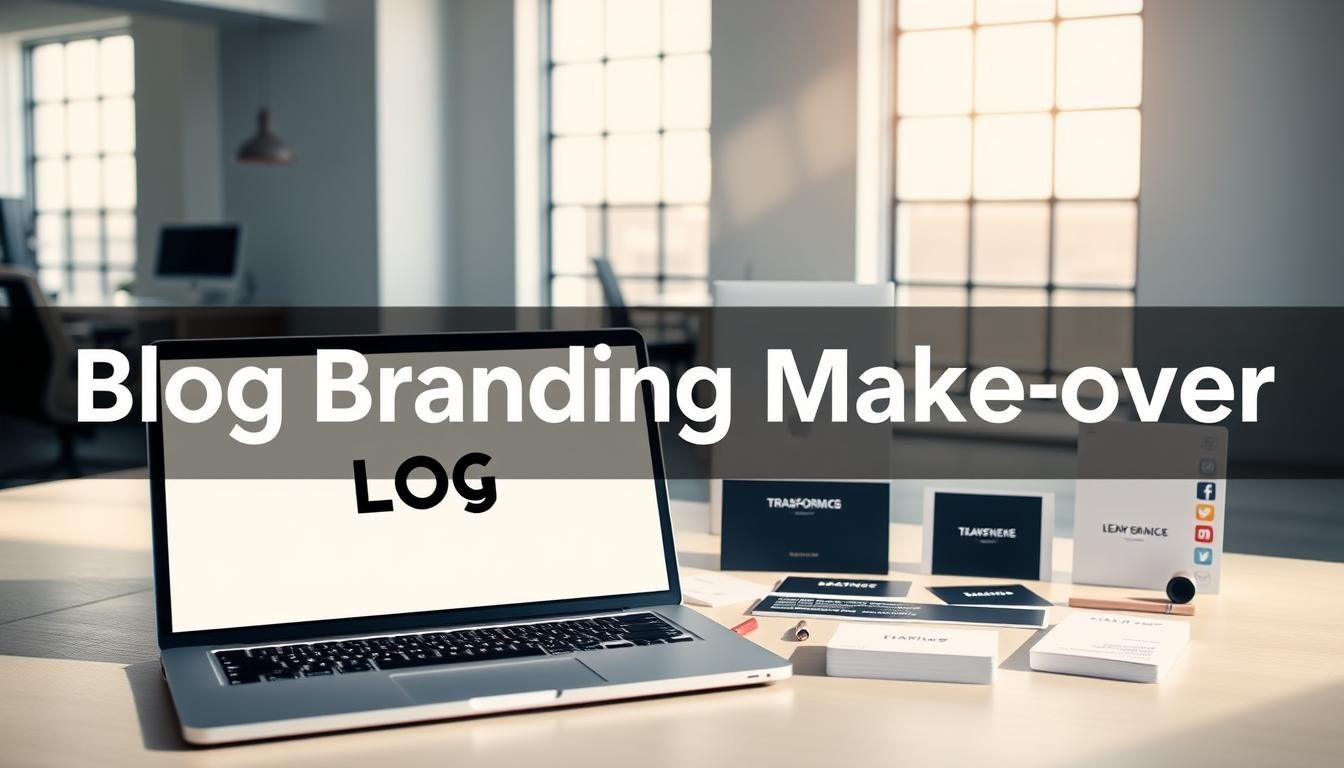Did you know that 75% of users judge a company’s credibility by its website design within seconds?
This reality makes a thoughtful makeover more than cosmetic. A clear identity and sharp site give your business an instant boost in trust. To track the impact of your makeover on user behavior, explore our guide on advanced traffic analytics dashboards.
A makeover can be light-touch—a color update and logo tweak—or deeper, aligning visual identity with a new strategy. For insights on building credibility through transparent practices, check out our guide on understanding blog income transparency. Every approach needs a plan that ties visuals, messaging, and target audience together.
When you map business goals to brand signals, small changes compound. Organized content, consistent fonts, and a simple logo help visitors understand your value fast. To complement your visual makeover with content strategy, explore our guide on developing a winning portfolio blogging strategy.
Later sections will help you choose between refresh, redesign, or rebrand, build a practical plan, and execute with copy, visuals, and UX. If you want a practical starting point now, see this guide for when your site needs professional help: website makeover guidance.
Key Takeaways
- First impressions from your website shape trust and credibility quickly.
- Choose a refresh, redesign, or full rebrand based on clear signals and goals.
- Align visuals, messaging, and UX with a documented strategy to avoid confusion.
- Small, consistent updates can drive steady growth over time.
- Practical, actionable steps cut risk and speed execution for decision-makers.
What a Blog Branding Makeover Is: Refresh vs Redesign vs Rebrand
A successful update begins by matching your visual choices to where the company is headed.
Brand refresh focuses on small, tactical updates. Think color palette tweaks, cleaner typography, and a simplified logo to improve legibility. These changes keep recognition intact while removing visible aging.
Brand redesign is a broader visual shift. It updates the design system—logo, patterns, and visual hierarchy—so your website and web assets reflect an evolving strategy and market position. A redesign may include a new logo or a refined mark.
Complete rebrand is a foundational move. It rethinks mission, positioning, and brand identity to reach a new audience. This path demands research, stakeholder alignment, and a clear vision before wholesale changes are made.
- Refresh = incremental updates to preserve equity.
- Redesign = noticeable visual system change to match new direction.
- Rebrand = strategic reset of mission and market positioning.
Rule of thumb: the larger the gap between your current brand and your vision, the more likely you need a redesign or rebrand. Assess your website and current brand assets for consistency before you decide.

For a practical checklist on whether your logo or brand needs work, see does your logo or brand need a.
Decide If Your Business Needs blog branding makeovers
Small signals from users and market shifts often reveal when your site and identity are out of step.
Start with simple diagnostic questions: how long since the last update, do your visuals feel dated, and does your current brand reflect the services you sell today?
Listen to customers and clients. If people can’t find core pages on your website or say your look feels off, that feedback points to change.
Check market shifts and competitor moves. New expectations or a different target audience can make existing identity hard to compare or sell against.

Quick mapping: symptoms → scope
- Messy navigation, low conversions, and unclear pages → consider a redesign.
- Outdated visuals or minor mismatch with your audience → start with a refresh.
- Major shifts in services, market, or mission → plan a rebrand.
“Users told us they couldn’t find our portfolio — that single comment triggered a full site review.”
Set measurable criteria—recognition, engagement, and clarity—and weigh time and resources so the business need matches the right scope.
Build a Strategy That Aligns Brand, Audience, and Market
Map your audience, services, and market gaps before you pick visuals or write a single page. A clear plan keeps design and copy focused on real business goals.
Define positioning, services, and target audience
Start with positioning: name who you serve, which services you prioritize, and how you solve problems better than alternatives.
Translate that into core identity elements—messaging pillars, value proof, and a simple narrative you can use across the website.
- Prioritize services that drive revenue and customer retention.
- Keep the target audience specific so messaging stays sharp.
- Use one short sentence that explains your main differentiator.

Dial in your brand voice versus tone for pages and social
Voice is your consistent personality; tone shifts by format and audience. Use voice to guide marketing and copy so every channel feels like the same organization.
Draft a few sample headlines, body snippets, and CTAs for landing pages and social posts. That makes it easier to protect clarity during reviews.
Set scope, resources, and timeline
Document owners, milestones, and a realistic time horizon so the project does not derail other business work. Align brand, marketing, and services stakeholders early to reduce rework.
Tip: close the planning stage with a one-page strategy summary that lists scope, content needs, and review roles. Use it as the single source of truth during execution.
“A compact plan saved our team weeks of rework by keeping decisions tied to one clear map.”
Execute the Makeover: Identity, Copy, and Web Design That Convert
Kick off execution with identity, copy, and site structure that answer user needs fast. Focus on fixes that improve clarity and reduce clicks so people find services and proof quickly.
Logo and visual system: start by solving common logo problems — ensure the logo scales, reads at small sizes, and works in one color for contrast. Build a flexible color palette and typography stack that supports hierarchy and accessibility.
Messaging that fits: turn your strategy into tight copy. Lead with clear value, answer top objections, and strengthen CTAs so clients choose with confidence. Rework core pages for clarity and scannability.
Website experience: map IA to user tasks. Prioritize pages and modules that surface services, proof, and pricing without extra clicks. Prototype flows, place CTAs where decisions happen, and keep key answers above the fold.
- Standardize identity rules—spacing, buttons, and illustration styles—so each page feels unified.
- Simplify backgrounds and use custom imagery to reinforce your story without distracting from CTAs.
- Align developers early on components and responsive rules; a WordPress build with Divi can speed delivery when in-house resources exist.
“Optimize hero headlines, CTA labels, and visual emphasis on priority sections to lift conversions during the makeover.”
Launch and Measure: SEO, Social, and Continuous Improvement
Before you hit publish, confirm the essentials that keep your site visible and reliable.
Pre-launch checklist
Quick technical and QA steps
Make sure copy is final and placeholders are removed. Verify internal and external links work and images are compressed and tagged for SEO.
Run device and browser tests, create a full site backup, and audit technical SEO so search engines can crawl the website without errors.
Prepare social media share images and metadata so every post looks polished and consistent with your brand.
Post-launch optimization
Track, learn, and iterate
Use analytics to answer the right questions: which page attracts and converts, where users bounce, and how long it takes customers to find key answers.
Track rebranding impacts by channel—compare pre/post traffic, engagement, and assisted conversions to validate your strategy and marketing choices.
Adjust tone and voice per channel while keeping the core message steady. Prioritize fixes that remove friction first: navigation clarity, CTA placement, and speed.
- Keep a change log to connect shipped updates to outcomes.
- Set a cadence for updates—weekly or biweekly—to maintain momentum and reduce time lost after launch.
- Audit social profiles and partner listings if the rebrand included a new logo or visual system.
| Stage | Key actions | Primary owner | Success metric |
|---|---|---|---|
| Pre-launch | Finalize copy, links, SEO audit, backups, share images | Content + Dev | Zero broken links; indexed pages |
| Launch | Enable analytics, monitor errors, announce on social media | Marketing | Uptime, initial traffic spike |
| Post-launch | Compare pre/post traffic, refine tone, fix high-friction pages | Growth team | Improved conversion rate; lower bounce |
“Iterate quickly: small, measurable changes beat big, untested guesses.”
Conclusion
Finish by linking the scale of change to real company goals so every step earns results.
Use the decision roadmap: mostly “A” answers point to a refresh, “B” to a redesign, and “C” to a full rebrand. Companies that clarified services and audience saw gains by organizing content, tightening visuals, and simplifying navigation.
Start small—ship obvious fixes first (clean CTAs, consistent headings, simpler menus). Then assign owners, set a realistic timeline, and ask clients for feedback early to validate direction.
Support the rollout with clear marketing, before/after examples, and a light process for continuous improvement. A focused strategy, tight copy, and consistent voice cut risk and help your brand feel familiar and fresh fast.
FAQ
What is the difference between a brand refresh, a redesign, and a complete rebrand?
A brand refresh updates visual elements like color, typography, and graphics to feel current while keeping recognition. A redesign gives your site and assets a new look that matches an updated strategy but preserves core identity. A complete rebrand reshapes mission, positioning, and visual identity to reach a new target market and may change name, voice, and services.
How do I know if my business needs a makeover for its online identity?
Look for clear signals: falling engagement, mixed customer feedback, market shifts, or misaligned messaging. If your website, social profiles, and color or logo no longer reflect your target audience, or your conversion rates slip, it’s time to evaluate a refresh, redesign, or rebrand.
What should I include in a strategy before starting a redesign or rebrand?
Define positioning, core services, and the exact target audience. Clarify brand voice and tone for pages and social media. Set scope, budget, resources, and a timeline so the project stays on track and ties design changes to business goals.
How do I pick the right visual system — logo, color palette, and typography?
Start with your brand personality and audience needs. Choose a scalable logo, accessible color palette, and readable typefaces that work across devices. Test combinations on real content to ensure clarity, consistency, and recognition.
What role does copywriting play in a makeover?
Strong messaging turns strategy into clear benefits. Use consistent voice across website pages and social channels so visitors quickly understand what you offer. Prioritize headlines, CTAs, and short benefits-driven paragraphs to boost conversions.
How long does a typical redesign or rebrand take?
Timelines vary by scope. A visual refresh can take a few weeks; a full redesign or complete rebrand often runs several months. Build time for research, content creation, design iterations, development, and testing into your schedule.
What should be on the pre-launch checklist?
Include technical SEO checks, internal link reviews, optimized share images, cross-browser and device tests, accessibility checks, and reliable backups. Also confirm messaging consistency and that analytics tracking is in place.
How do we measure success after launching the new identity?
Track engagement metrics by channel, page bounce rates, conversion actions (signups, sales, inquiries), and social feedback. Compare before-and-after data, and run user tests or surveys to capture qualitative insights.
Can I update parts of my identity gradually or should I relaunch everything at once?
Both approaches work. Staged rollouts reduce risk and spread cost; a full relaunch creates a clear market moment. Choose based on resources, audience sensitivity, and the extent of change needed.
How can small businesses on a budget handle a remodel of their online presence?
Prioritize high-impact items: clear messaging, a focused homepage, mobile UX, and a simple, flexible logo and palette. Use templates or modular design systems, and phase in deeper changes as revenue allows.
What common mistakes should I avoid during a redesign or rebrand?
Avoid inconsistent voice across channels, skipping user research, neglecting SEO redirects, and overcomplicating design. Also don’t change core messaging without testing how customers perceive the shift.
How do I keep the new identity consistent across website, social media, and marketing materials?
Create a concise brand guide that covers voice, tone, logo use, colors, typography, and imagery. Share templates for social posts and web pages so team members and vendors maintain uniformity.
Should I involve customers in the process?
Yes. Gathering customer feedback through surveys, interviews, or test groups helps validate direction and reduces risk. Their input can guide tone, visuals, and feature priorities.
How do SEO and content strategy fit into a makeover?
Integrate keyword research and content mapping early. Preserve high-value URLs or set proper redirects, optimize metadata, and align content with user intent so traffic and rankings don’t drop after launch.
What resources or professionals should I hire for a successful project?
Consider a mix of strategy, copywriting, graphic design, UX/UI, front-end development, and SEO expertise. For smaller projects, a versatile agency or experienced freelancer can cover multiple needs.
